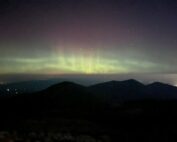Pressure and Wind on the Summit
2014-02-16 19:44:07.000 – Mike Dorfman, Weather Observer
Graph of the windspeed (top) and pressure (bottom)
The last few days have been full of change. On two occasions in the last few days, we had winds drop below 10 mph, just to rapidly ramp up again to near hurricane force. As a few of our overnight guests said when arriving on the summit last night in calm winds, ‘This is Mount Washington?’ Yes, yes it is. As if the mountain heard their statement, winds were gusting upwards of 60 mph when they woke up this morning.
So, why so much change in so little time? Imagine a soda bottle after shaking it up. Pressure inside the bottle is greater than outside, so when you open the cap, you can hear the hissing noise of air shooting out. Our atmosphere is similar. Areas of high and low pressure form due to the uneven heating of the earth’s surface. The atmosphere wants to counteract these low or high pressure anomalies, so there is movement of air, just like in a soda bottle. Due to the large scale of these systems however, the air does not equilibrate immediately like your soda bottle. These pressure differences, and the air movement attempting to correct them, is what creates our wind.
The summits get much stronger wind than the valleys for several reasons. First, the friction between moving air and the ground slows air’s movement down to a large extent. Since Mount Washington is high above the valley, the air at our level has not been as affected by the ground as the air closer to the valley, allowing it to travel faster.
The summits also get extreme wind due to what is called the Venturi Effect. As air travels up and over the mountain, it is forced to travel through a smaller area. Like putting your thumb over the end of a garden hose, it is then forced to accelerate.
Wind on the summit has changed so rapidly the past few days due to the strong pressure gradients associated with the low pressure systems, in addition to the specific track of the low pressure systems. The first major lull in the center of the graph attached to this comment correlates to the low pressure system passing overhead. As the center of the low passed overhead, the gradient slackened and winds dropped off. The center of the low then continued moving northeast, putting us back in the steep pressure gradient on the backside of the low.
If you don’t like the weather, wait a minute or two and you can see drastically different conditions up here on the summit!
Mike Dorfman, Weather Observer
Inside the Weather Room: How Mount Washington Observers Monitor the Atmosphere
Inside the Weather Room: How Mount Washington Observers Monitor the Atmosphere By Karl Philippoff As a weather observer on Mount Washington, we take our hourly observations on the observation deck, usually heading out between
From Weather Observer to Intern, to Observer Again
From Weather Observer to Intern, to Observer Again By Madelynn Smith As I rode in the backseat of our Obs van up the Auto Road for the first time as a full-time employee at
From Mountains to More Mountains
From Mountains to More Mountains: This Time with Stronger Winds By Alyssa Bélanger On the observation deck in high winds. Hello there! My name is Alyssa Bélanger and I am a fall






